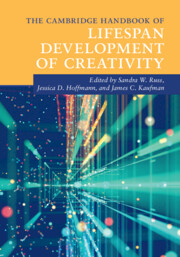Book contents
- The Cambridge Handbook of Lifespan Development of Creativity
- The Cambridge Handbook of Lifespan Development of Creativity
- Copyright page
- Dedication
- Contents
- Figures
- Tables
- Contributors
- Acknowledgments
- Introduction
- Part I Core Concepts of Lifespan Creativity Development
- Part II The Development of Creativity
- Part III Modes of Enhancement
- 12 Domain-Specific Talent Development
- 13 Enhancement of Creativity across the Lifespan in Mainland China
- 14 Beyond Flights of Fancy?
- 15 Creating Imaginary Worlds across the Lifespan
- 16 Imaginative Creativity in the Writing and Reading of Stories
- 17 The Effects of Video Games on Creativity
- Part IV Environments and Contexts
- Part V Special Populations
- Index
- References
16 - Imaginative Creativity in the Writing and Reading of Stories
from Part III - Modes of Enhancement
Published online by Cambridge University Press: 19 November 2021
- The Cambridge Handbook of Lifespan Development of Creativity
- The Cambridge Handbook of Lifespan Development of Creativity
- Copyright page
- Dedication
- Contents
- Figures
- Tables
- Contributors
- Acknowledgments
- Introduction
- Part I Core Concepts of Lifespan Creativity Development
- Part II The Development of Creativity
- Part III Modes of Enhancement
- 12 Domain-Specific Talent Development
- 13 Enhancement of Creativity across the Lifespan in Mainland China
- 14 Beyond Flights of Fancy?
- 15 Creating Imaginary Worlds across the Lifespan
- 16 Imaginative Creativity in the Writing and Reading of Stories
- 17 The Effects of Video Games on Creativity
- Part IV Environments and Contexts
- Part V Special Populations
- Index
- References
Summary
In this chapter, the creative processes that are explored include those of writers and readers. Narrative stories derive from conversation, which is thought to have begun with the evolution of language between 500,000 and 100,000 years ago. Conversation is a mode in which people develop and sustain relationships by sharing memories, perceptions, emotions, anecdotes, thoughts, and understandings – pieces of consciousness – with others. It’s fundamentally creative; each conversation today, engaged in by each of the world’s 7.5 billion inhabitants, with relatives, friends, and other people, is unique, as have been all other conversations. Written stories, which started some 5,000 to 4,000 years ago, have taken this further, with pieces of consciousness being sent by writers to others whom they do not usually know.
Information
- Type
- Chapter
- Information
- The Cambridge Handbook of Lifespan Development of Creativity , pp. 351 - 367Publisher: Cambridge University PressPrint publication year: 2021
